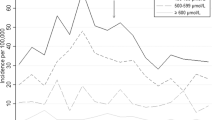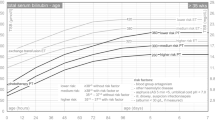Abstract
Neonatal hemolytic jaundice is a risk factor for kernicterus. Pyruvate kinase (PK) deficiency is a rare cause of neonatal hemolytic jaundice, with a prevalence estimated at 1 case per 20 000 births in the United States, but with a higher prevalence among the Amish communities in Pennsylvania and Ohio. We discovered four neonates with PK deficiency born in a small community of polygamists. All four had early, severe, hemolytic jaundice. PK deficiency should be considered in neonates with early hemolytic, Coombs-negative, non-spherocytic jaundice, particularly in communities with considerable consanguinity. Such cases should be recognized early and managed aggressively to prevent kernicterus.
This is a preview of subscription content, access via your institution
Access options
Subscribe to this journal
Receive 12 print issues and online access
$259.00 per year
only $21.58 per issue
Buy this article
- Purchase on Springer Link
- Instant access to full article PDF
Prices may be subject to local taxes which are calculated during checkout

Similar content being viewed by others
References
Glader B . Hereditary hemolytic anemias due to red blood cell enzyme disorders. In: Greer JP, Foerster J, Rodgers GM, Paraskevas F, Glader B, Arber DA, Means Jr RT (eds). Wintrobe's Clinical Hematology, 12th edn, Lippincott/Williams & Wilkins: Philadelphia, 2009, pp 942–944.
Zanella A, Ferno E, Bianchi P, Valentini G . Red cell pyruvate kinase deficiency: molecular and clinical aspects. Br J Haematol 2005; 130 (1): 11–25.
Zanella A, Fermo E, Bianchi P, Chiarelli LR, Valentini G . Pyruvate kinase deficiency: the genotype-phenotype association. Blood Rev 2007; 21 (4): 217–231.
Muir WA, Beutler E, Wasson C . Erythrocyte pyruvate kinase deficiency in the Ohio Amish: origin and characterization of the mutant enzyme. Am J Hum Genet 1984; 36 (3): 634–639.
Bowman H . Pyruvate kinase deficient hemolytic anemia in an Amish isolate. Am J Hum Genet 1965; 17: 1–8.
Beutler E, Gelbart T . Estimating the prevalence of pyruvate kinase deficiency from the gene frequency in the general white population. Blood 2000; 959 (1): 3585–3588.
Subcommittee on Hyperbilirubinemia, American Academy of Pediatrics. Clinical Practice Guideline Management of Hyperbilirubinemia in the Newborn Infant 35 or More Weeks of Gestation. Pediatrics 2004; 114: 297–319.
Eggert LD, Wiedmeier SE, Wilson J, Christensen RD . The effect of instituting a prehospital-discharge newborn bilirubin screening program in an 18-hospital health system. Pediatrics 2007; 117: e855–e862.
Christensen RD, Jopling J, Henry E, Wiedmeier SE . The erythrocyte indices of neonates, defined using data from over 12 000 patients in a multihospital health care system. J Perinatol 2008; 28 (1): 24–28.
Christensen RD, Henry E . Hereditary spherocytosis in neonates with hyperbilirubinemia. Pediatrics 2009; 123: (in press).
Michaels LA, Cohen AR, Zhao H, Raphael RI, Manno CS . Screening for hereditary spherocytosis by use of automated erythrocyte indexes. J Pediatr 1997; 130 (6): 957–960.
Qurtom HA, al-Saleh QU, Lubani MM, Hassanein A, Kaddoorah N, Qurtom MA et al. The value of red cell distribution width in the diagnosis of anaemia in children. Eur J Pediatr 1989; 148: 745–748.
Johnson L, Bhutani VK, Karp K, Sivieri EM, Shapiro SM . Clinical report from the pilot USA kernicterus registry (1991 to 2004). J Perinatol 2009; 29 (Suppl 1): S25–S45.
Stevenson DK, Wong RJ, DeSandre GH, Vreman HJ . A primer on neonatal jaundice. Adv Pediatr 2004; 51: 263–288.
Newman TB, Liljestrand P, Escobar GJ . Infants with bilirubin levels of 30 mg/dL or more in a large managed care organization. Pediatrics 2003; 111: 1303–1311.
Kaplan M, Hammerman C, Vreman HJ, Wong RJ, Stevenson DK . Severe hemolysis with normal blood count in a glucose-6-phosphate dehydrogenase deficient neonate. J Perinatol 2008; 28: 306–309.
Oski FA, Nathan DG, Sidel VW, Diamond LK . Extreme hemolysis and red-cell distortion in erythrocyte puryvate kinase deficiency. N Engl J Med 1964; 270: 1023–1030.
Acknowledgements
We thank Bertil Glader, MD, PhD, Stanford University Medical Center, Palo Alto, California, for interpreting the erythrocyte pyruvate kinase values on these patients.
Author information
Authors and Affiliations
Corresponding author
Rights and permissions
About this article
Cite this article
Christensen, R., Eggert, L., Baer, V. et al. Pyruvate kinase deficiency as a cause of extreme hyperbilirubinemia in neonates from a polygamist community. J Perinatol 30, 233–236 (2010). https://doi.org/10.1038/jp.2009.118
Received:
Revised:
Accepted:
Published:
Issue Date:
DOI: https://doi.org/10.1038/jp.2009.118
Keywords
This article is cited by
-
Health Beliefs and Practices in an Isolated Polygamist Community of Southern Utah
Journal of Religion and Health (2013)



